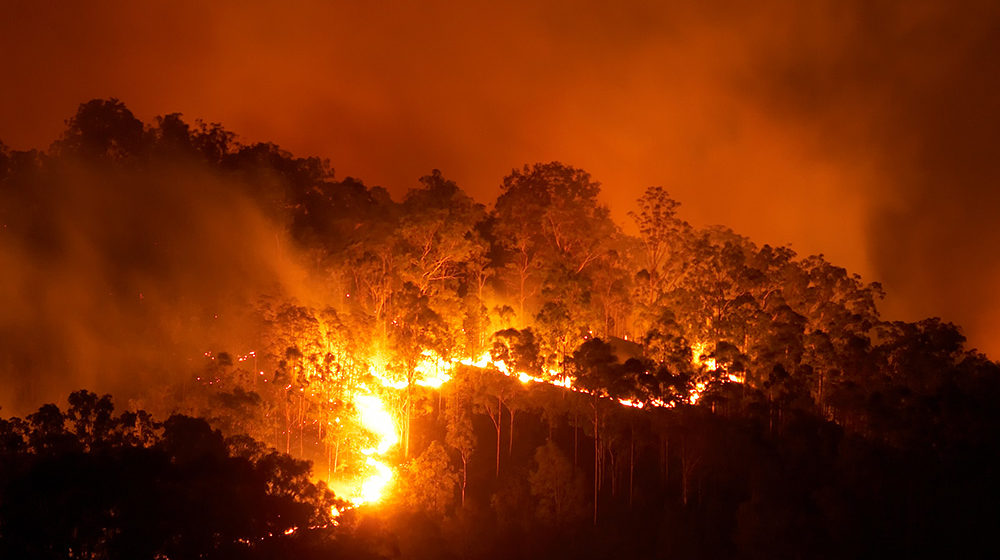Snapshot
- This December, world leaders gathered in Madrid for COP25, the 2019 United Nations Climate Change Conference, in a desperate effort to ensure that States live up to their commitments under the 2015 Paris Agreement.
- Meanwhile, private individuals, corporations and regulators are also tackling the issue in terms of financial risk management.
- In 2020, the Federal Court of Australia is set to decide whether REST super fund has breached the Superannuation Industry (Supervision) Act 1993 and the Corporations Act 2001 (Cth) by failing to disclose and manage the way climate change could impact its assets and investments.
- If successful, the case would make Australia a leading jurisdiction in requiring banks, funds and companies to take climate change-related risks seriously.
In mid-2017, a 23-year-old landscaper named Mark McVeigh took aim at one of the largest financial institutions in Australia, the Retail Employees Superannuation Trust (‘REST’) (see McVeigh v Retail Employees Superannuation Pty Ltd [2019] FCA 14 per Perram J, for a helpful summary of the early stages of this case).
REST is among the 12 largest super funds, with $57 billion under management for its roughly 2 million members, many of whom are young (the fund members’ average age is about 31) and work in retail jobs, including as part-time and casual employees (see: www. REST.com.au/about-us). It also happens to be McVeigh’s super fund. Thanks to a provision of the Corporations Act 2001 (Cth), as a member of REST, McVeigh is entitled to request and receive from the fund information that he reasonably requires to make ‘an informed judgment about the management and financial condition of … the superannuation entity.’ (Corporation Act 2001 s 1017C(2)(c)(i)).
What McVeigh particularly wanted to know was how REST’s trustees were managing risks arising from climate change.
In his filings to the Federal Court, McVeigh set out the back-and-forth he had with REST as he tried to obtain that information. He asked how the fund understood the risks it faced from climate change, and how it was responding to those risks. He sought information about the steps REST had taken to require its investment managers provide information about climate risk, as well as how it had complied with other fiduciary duties (Amended Concise Statement, 21 September 2018).
REST answered with some information, but, in McVeigh’s view, it wasn’t good enough to give him a real understanding of how his retirement savings were being managed, given his belief that climate change will have a ‘major impact on the financial condition and/or investments performance of REST’ (Amended Concise Statement, 21 September 2018). So he sought a declaration from the Court that REST had breached its obligations to him, both under the Superannuation Industry (Supervision) Act 1993 (‘SIS Act’), as well as in equity. Specifically, he claimed that REST had breached its duty to exercise ‘the same degree of care, skill and diligence as a prudent superannuation trustee would exercise’ and ‘to perform the trustee’s duties and exercise the trustee’s powers in the best interests of the beneficiaries’ (SIS Act ss 52(2)(b) and (c)). He also sought an injunction forcing REST to stop breaching those obligations.
In other words, McVeigh wants the Court to force REST to provide a detailed, granular view of how it thinks its investments might be affected by climate change – including higher temperatures; more frequent and intense storms, droughts, fires, floods; disrupted supply chains; potentially plummeting values of certain companies whose businesses involve emitting greenhouse gases (‘stranded assets’); and all of the social and political turmoil those changes will continue to exacerbate.
The case is still in the preliminary stages, and REST has denied most of the substantive allegations (Concise Statement in Response to Amended Concise Statement, dated 1 April 2019). In late November, the Court issued discovery orders and set a trial date for July 2020 (No: NSD1333/2018).
In this article, we express no view on the merits of McVeigh’s arguments. Rather, we wish to explain what his arguments would require many Australian organisations to do in terms of climate change, and to set out what regulators have already said in this regard.
This insight – that climate risk should be assessed as financial risk – has transformed the way that regulators are approaching climate change. Climate risk is not just about how a particular company impacts the climate, but also, how climate change will affect each company, fund, or other entity.
The legal duty to manage climate change risk
In 2016, the Centre for Policy Development published a legal Memorandum of Opinion on ‘Climate Change and Directors’ Duties’ by highly-regarded barristers Noel Hutley SC and Sebastian Hartford-Davis. The Memorandum considered ‘the extent to which the law permits or requires Australian company directors to respond to “climate change risks”,’ in the specific context of directors’ duty of care and diligence under s 180(1) of the Corporations Act.
Hutley and Hartford-Davis concluded that ‘it is conceivable that directors who fail to consider “climate change risks” now, could be found liable for breaching their duty of care and diligence in the future’ (see: https://cpd.org.au/wp-content/uploads/2016/10/Legal-Opinion-on-Climate-Change-and-Directors-Duties.pdf.)
In 2017, Hutley issued an opinion with barrister James Mack on the comparable duty in
s 52 of the SIS Act, which requires superannuation trustees to act with care, skill and diligence, and in the best interests of members. They concluded that, ‘it is incumbent upon a trustee director, in an appropriate case, to consider the climate change risk.’ (Hutley and Mack, “Market Forces: Superannuation Fund Trustee Duties and Climate Change Risk” 15 June 2017)
Crucially, Hutley and Mack noted that the courts have interpreted ‘best interests’
within s 52 as referring to members’ financial best interest. They argued that because climate risk leads to financial risk, ‘climate change risks can and should be considered by trustee directors to the extent that those risks may intersect with the financial interests of a beneficiary of a superannuation fund.’
This insight – that climate risk should be assessed as financial risk – has transformed the way that regulators are approaching climate change. Climate risk is not just about how a particular company impacts the climate, but also, how climate change will affect each company, fund, or other entity.
The regulators agree: climate risk is financial risk
As of this writing, all major Australian financial regulators have made clear that they share this view.
In 2016, APRA formally made climate change a ‘thematic supervision priority’ and began to train its supervisors in relation to this risk (APRA Information Paper, ‘Climate change: Awareness to action’, 20 March 2019, p 20). APRA is the regulator with broad responsibility to ensure that Australia’s financial system is sound, which it does by setting rules about risk management, and enforcing those rules. It oversees banks, credit unions, superannuation funds, insurers, reinsurers and some other entities.
In the same report, it said that climate change must be considered as a risk within the two key risk management standards that apply to banks and superannuation funds, respectively, Prudential Standard CPS 220 Risk Management (CPS 220) and Prudential Standard SPS 220 Risk Management (SPS 220) (p 20).
ASIC Commissioner John Price has also been outspoken in his view that climate change must be integrated into corporate governance and disclosures, and said more than a year ago that ASIC views the Hutley-Hartford-Davis opinion as ‘legally sound’ and ‘reflective of our understanding of the position under the prevailing case law in Australia in so far as directors’ duties are concerned’ (see: https://asic.gov.au/about-asic/news-centre/speeches/
climate-change/). In August this year, ASIC added specific reference to climate change to its formal guidance on what must be disclosed in prospectuses and operating and financial reviews.
‘When a central bank, a prudential regulator and a conduct regulator, with barely a hipster beard or hemp shirt between them, start warning that climate change is a financial risk, it’s clear that position is now orthodox economic thinking.’
And Guy Debelle, Deputy Governor of the Reserve Bank of Australia, gave a speech earlier this year in which he detailed the economic turmoil that could arise if climate risks are not properly managed and mitigated, saying, ‘[b]oth the physical impact of climate change and the transition are likely to have first-order economic effects.’
As Geoff Summerhayes, Executive Board Member of APRA, recently said in a speech to the International Insurance Society Global Insurance Forum: ‘When a central bank, a prudential regulator and a conduct regulator, with barely a hipster beard or hemp shirt between them, start warning that climate change is a financial risk, it’s clear that position is now orthodox economic thinking.’
The question then becomes: How does one satisfy the legal and regulatory obligations to assess and disclose climate change-related risks?
Emerging standard: Taskforce for Climate-related Financial Disclosures
An especially interesting aspect of McVeigh’s argument is that a prudent superannuation trustee would have required its investment managers to provide information about the fund’s climate risks to the Board, and that it should have ‘ensured that the processes it has in place for managing investments and disclosing REST’s Climate Change Business risks to beneficiaries complied with the recommendations of the Task Force on Climate-related Financial Disclosures (TCFD)’.
‘TCFD’ has become a short-hand reference to the series of recommendations published in a 2017 report by the body of the same name that was set up by the Financial Stability Board, whose members comprise many of the world’s central banks.
The recommendations fall into four categories: governance; strategy; risk management; and metrics and targets. The report includes guidance on how organisations should make the disclosures. For instance, disclosures should present relevant information; be specific and complete; and be comparable within a sector, industry or portfolio.
TCFD also encourages organisations to use scenario analysis to stress test their business and assets under at least three different possible futures of climate change. These would usually include a scenario where the world managed to limit warming to 1.5 degrees Celsius above pre-industrial temperatures – a goal that would lead to relatively less physical destruction and damage but which would require rapid measures to cease emitting greenhouse gases and also to begin sequestering them back out of the atmosphere. It may imply divestment from fossil fuel companies, as well as transformation of energy, transportation and building and construction sectors. But it could also include significant opportunities, particularly in the technologies required for that transition, and the financing that would be required.
Another scenario would usually be a high-end warming outcome, where business continues ‘as usual’ and results in warming of 3 to 4 degrees Celsius within a century. That scenario may result in fewer short-term adjustments to business practices and balance sheets, but it would almost certainly result in more frequent and catastrophic disruption and destruction of property and the environment. (Many scientists also think that warming above 3 degrees Celsius would result in the collapse of human civilization – also bad for business.
It’s worth noting that TCFD requires individual organisations to undergo very specific, tailored exercises to properly identify their climate risks. The risks will differ based on things like how vulnerable their assets are to climate change, including how close a particular building is to the coast, and how likely it is to suffer damage and lost value due to sea level rise, increased storms, bush fires etc – known as physical risk. Currently, many companies are taking stock of the cost of damage to their operations from this year’s catastrophic fire season; that’s the type of risk that is likely to increase with climate change, with significant implications for profit-margins and even, potentially, the viability of certain projects or business.
The second category is known as transition risk, which includes changes to domestic and international laws, policy, lawsuits, technology, customer demands. Part of managing transition risk is identifying potentially ‘stranded assets’ such as stock in coal companies.
[I]n the time since McVeigh filed his case, REST has taken various steps to increase its disclosure and management of climate risks. It now has a Climate Change Position Statement which says the fund factors climate change risks into its ‘investment strategy and decision-making’.
McVeigh’s case is a piece of strategic litigation that aims to enshrine in Australian law that superannuation funds must consider, assess, disclose and manage climate change-related risks and opportunities in accordance with TCFD. It would certainly go further than what the regulators have said; while they have been clear that climate change amounts to a financial risk that must be assessed and disclosed, they have encouraged – rather than required – the use of TCFD as one way of doing so.
It is particularly interesting to attempt this strategy in relation to superannuation, and not just because the Australian superannuation industry has trillions of dollars under management. While super funds do sometimes make direct investments (e.g. buying buildings), they more typically own stock in companies. Requiring them to understand all of their climate risks raises questions about whether they would then need to obtain specific reports from companies they invest in. If that occurred, it could have a force-multiplier effect, leading many more entities to assess, disclose and manage their climate risks in order to attract or retain investments from super funds—a motivating factor in addition to complying with requirements that regulators have not yet enforced.
Ambitious though this case may seem, it is not out of step with developments in other jurisdictions. For instance, France has already legislated to require companies to report on climate risk, and New Zealand has just announced that it has legislated similar requirements for government by actually adopting the TCFD framework as its official compliance benchmark. Fiji’s Climate Change Bill includes disclosure requirements and recommends TCFD as ‘industry best practice’ (Climate Change Bill 2019, s 105).
More broadly, we are seeing an increasing willingness from companies and even public authorities to adopt some version of TCFD and climate risk assessment and disclosure. Since its launch, nearly 900 organisations have become official TCFD ‘supporters’, including many of the world’s best known brands. Importantly, in Australia, super funds have a mixed record, with some established as fossil fuel free, others engaging in TCFD-like processes, while others are lagging.
And, in the time since McVeigh filed his case, REST has taken various steps to increase its disclosure and management of climate risks. It now has a Climate Change Position Statement which says the fund factors climate change risks into its ‘investment strategy and decision-making’ and it has joined Principles for Responsible Investment (‘PRI’), a group whose members promote environmental, social and governance principles. From 2020 onwards, PRI will require its members to follow TCFD. (See: https://www.rest.com.au/
member/investments/climate-change-statement)
But there is still significant room for improvement.
In March this year, APRA published the results of a survey it had conducted of 38 large entities it regulates in order to assess the extent to which they were complying with these obligations. It found that while banks and other authorised deposit-taking institutions understood that climate risk is a financial risk, it appeared that insurers – particularly, life and private health insurers – were lagging, still saying that climate change was a matter for corporate social responsibility. APRA also found that the extent to which respondents were disclosing these risks, was ‘mixed.’
APRA signalled that it intends to ‘increas[e] the intensity of its supervisory activities to assess the effectiveness of risk identification, measurement and mitigation strategies adopted by APRA-regulated entities’ (p10).
It will be interesting to watch how this rapidly advancing area of law – and its enforcement – continue to develop in 2020.






